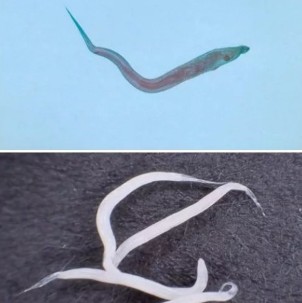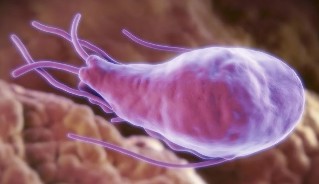The types of parasites in the human body is extremely diverse. One of them, along with a large number of cells, and protozoa, are also the viruses, bacteria, and fungi, which parasitize the human body and even in the medical tradition of the viruses and bacteria that are not considered to be parasites.

In the human body, the various types of parasites, which are localized not only in the intestine, as is commonly believed, but also in many other organs: the blood, the tissues, the muscles, the joints and the brain (head and spinal), and even in the eyes of the.
Particularly affected by internal organs, such as the gastrointestinal tract, the liver, the lungs, the heart.
Residence of parasites in the human body, it is far from trivial. The adverse effects lies mainly in the fact that they absorb a significant portion of dietary nutrients, without which the entire functioning of the organism impossible.
An imbalance of the impact of the General intoxication of the human body due to the toxins released by the parasites, which can lead to the development of a number of diseases by a cancer. Often, a disease caused by parasites, it becomes chronic.
A particular danger lies in the fact that in the parasitic disease is caused by the symptoms characteristic of the other, and often of the intestinal infection and that is why it is very important for timely differential diagnosis by the identification of the species of the parasite, and develop an adequate strategy of treatment.
The species of human parasites in General can be divided into two main categories:
- ectoparasite a parasite on the body surface and feeding on the blood of humans (bedbugs, fleas, face mites), which are carriers of pathogens of such diseases as encephalitis, typhoid, anthrax, etc.;
- endoparasite parasitic on the internal organs and cause serious diseases; these include the protozoa (Giardia, amoeba, Trichomonas, Toxoplasma) and helminths – parasitic worms (worms).
The classification of the parasites

Let us look at the major classes of endoparasites of man. The appearance of many of them can only be seen under a microscope, and some of it, particularly helminths, have an impact on the size of the. Let's start with the easiest:
- Of Giardia along with the liver is also a cause of hypovitaminosis, anemia, and a General poisoning of the organism.
- Toxoplasma affects the brain, eyes, heart, muscles, and nervous system, but the specific risks they pose to pregnant women, because of the risk of fetal death or to serious injury.
- The amoeba can cause amoebic dysentery, amoebic encephalitis and other dangerous diseases.
- Trichomonas is a source of infectious diseases of the musculoskeletal system and connective tissue.
The most common types of parasites
The most common endoparasite are, of course, the helminths (worms), which, according to various estimates, infected more than 80% of the world's population.
A large number of these parasites, which are divided into basic types:
- nematodes – round worms (roundworm, pinworm, Trichinella, whipworm, etc.);
- cestodes – tapeworms (lantecy, pork and beef tapeworm, Echinococcus, etc.);
- trematodes – worms-flukes (liver, blood, lungs, and the flukes that live in the gut).
Sometimes, you can also find a more General way, the classification, according to which all types of parasites, people can be divided into:
- intestinal, parasites in the intestine;
- tissue, localized in other organs and tissues.
However, the majority of the worms at different stages of their life cycle, and tissues, and the intestinal development of the period, with the corresponding symptoms.
Consider a brief description of the most common types of worms.
Roundworms (nematodes)
- Roundworm – roundworms are the most common length of 20 to 40 cm, parasites in the small intestine, but the first move in the human body that affect the blood and the respiratory system. Along with these intestinal parasites can be detected in the liver and the gall bladder, the heart and the lungs. A common symptom of ascariasis and allergic reactions.
- Pinworms – small worms, up to 1 cm, which affects the intestines and can lead to enterobiasis disorders of the digestive system, exhaustion, sleep disorders, etc., a Typical symptom of pinworms is itching in the anus, where they lay their eggs.
- Trichinella – these are microscopic worms (the size of only a few millimeters in length) can lead to the serious disease trichinosis, which can, if untreated, may lead to death. The adults of the species that live in humans in the muscles (respiratory, face, etc.), causing pain in the muscles, fever, swelling of the allergic rash on the skin.
- Vlasoglavy – you have a small (length up to 4.5 cm, from the anterior part of the body,

The larvae, which cause trichocephalosis, with the diarrhoea, an acute pain in the abdominal pain and other symptoms that resemble appendicitis. As a result of the poisoning of anemia.
Tapeworms (cestodes)
- A tapewormis the length of the body ranges up to 10 m, which leads to the development of the difillobotrioz, with nausea, weakness, vomiting, unstable stool, asthenia, and anemia.
- Pork tapeworm has a length of from 3 to 8 m, and the parasite, primarily in the small intestine, and the causes of the two diseases: taeniasis by the dyspeptic, asthenic-neurotic and in the abdominal syndromes, and cysticercosis, with the intoxication, gastrointestinal, allergic, and respiratory. Depending on the localization of tsistitserki effect on the muscles, the brain, the heart, the eyes, etc.
- Beef tapeworm, the length of which can reach up to 18 m, and is the beef tapeworm infection is considered to be one of the most dangerous types of worms. If you are not engaged in the dehelmintization, it can stay in the body up to 18 or 20 years old. It is localized in the large intestine, causing severe poisoning, with its resultant product, as well as diarrhoea, nausea, vomiting, abdominal pain, anemia, allergic reactions, and problems with the nervous system.
- The dwarf tapeworm the length of only 1.5-5 cm of the source of the gimenolepidoz with dyspeptic pain and astheno-neurotic syndromes, which affect above all the digestive and the nervous system and the liver.
- Echinococcus is considered to be the smallest of the ribbon so its length is from 2.5 to 8, rarely 9-mm, however, the infection has severe consequences, such as the liver and lungs, where they form cysts and tumors which cause damage to these organs.

Worms-flukes (trematodes)
- The liver fluke or the liver Fluke is shaped like a sheet with a length of 30-50 mm and a width of 8-13 mm, and has a suction Cup. This damages the sheath of the liver and clog the bile ducts, which can completely block the flow of bile. Can lead to cirrhosis, jaundice and cancer of the liver.
- The cat (a Siberian) fluke cat, or Fluke, a flat worm with a length of 4-13 mm. Localization – the ducts of the gallbladder, liver, and pancreas. The causes of opisthorchiasis, with the development of gastritis, ulcers, pancreatitis, cholecystitis, as long as the cancer of the liver, which can lead to death.
- The lung fluke is an egg-shaped form, red-brown body with small spines, length of 7.5 to 12 mm, and a width of from 4 to 8 mm. Affects the lungs, causing inflammation, pleural effusion, focal fibrosis, and lung cancer. When the penetration into the brain, causing encephalitis, and meningoencephalitis.
- Shistosoma (blood flukes) – dioecious worms the size of 1-2 cm) of the egg, which causes an increase in the liver, spleen, and lymph nodes, the formation of polyps in the colon, diarrhea, granulomatous inflammation, leading to cancer of the bladder.
The sources of infection

Helminthiasis can lead to a range of medical problems, which reduce the lifespan of 15-25 years of age. A lot of parasites are very difficult to detect. You can be anywhere in the blood, intestines, lungs, heart, and brain. The symptoms of a worm infection may be confused with SARS, gastrointestinal illnesses, and so forth. The fundamental error in such cases the delay! If you are suspicious for the presence of parasites, you need to see a specialist. When it comes to medication and self-treatment against the most common helminths (Ascaris, pinworms, tapeworms), which is suitable for antiparasitic are complex.
Helminthiasis, other intestinal diseases, it is often the "disease of dirty hands", which leads to the accumulation of eggs and larvae of helminths in the human body:
- when you don't wash their hands after using the toilet and before eating;
- no, the washing of vegetables, fruits, and greens that are consumed raw;
- do not put meat and fish are of a sufficient heat treatment;
- the improper consumption of salted fish, and bacon;
- just leave the food accessible to flies and cockroaches;
- the use of sludge as a fertiliser for the garden plots;
- swimming in the ponds;
- in contact with a stray animal.

However, your pet can also be infected by worms, because, often, animals serve as intermediate hosts for helminths, but the primary host is a human.
The methods of the fight
- From a very early age, to instill in the children the habit of washing hands. They need to do more than what is constantly playing in the sand, the earth, the cell, where it is most advantageous terms and conditions for the eggs and larvae of parasites, and contact with Pets and street animals.
- If you experience any discomfort, it cannot be ruled out, the bot, therefore, it is recommended to carry out suitable tests for parasites, to identify the particular species of helminth (at most one of them there are medications.
- If parasites are detected in one family member, the use of the bot has to take all of it.
- Folk medicine knows many ways on how to get rid of the worms, and put in a good performance.
- Do not leave an open-cook meals, bread, pastry, cakes, etc., to the flies, or cockroaches carry eggs of intestinal worms – they are not left on the product.
- Carefully observe the temperature regime in the process of cooking the meat and fish that are frequently found helminth eggs is to boil/fry/bake.
- Rinse well under running water, the vegetables, the fruits, the greens, which are consumed raw.
- Regularly deworming Pets.
- To desist from using faeces as fertilizer in their garden plots.
- If you are traveling to an exotic country, very close attention to the local cuisine, especially the street – there is no guarantee that these will not catch some of the more exotic vermes.






































